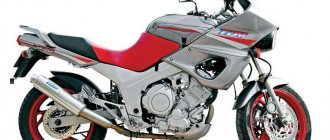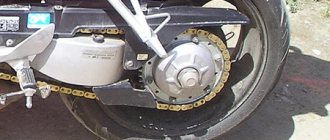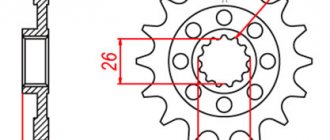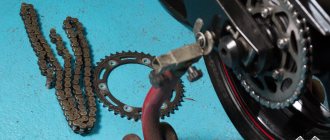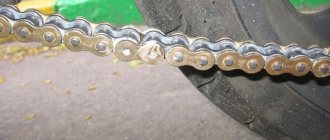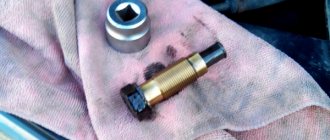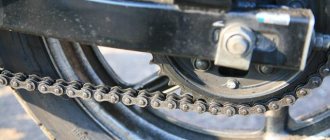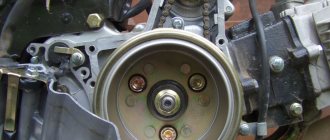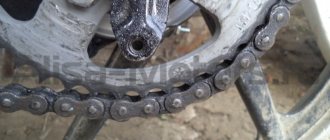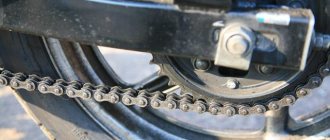For more than 85 years, the German company Esjot has been producing drive mechanisms. Over its long history, Esjot has created an innovative product - high-quality drive chains for motorcycles. Together with Japanese engineers RK CHAIN, chains have been produced with characteristics that exceed OEM standards and guarantee long service life. Esjot drive sprockets and chains rightfully occupy a leading position in the motorcycle spare parts market. You can buy a chain for an ESJOT motorcycle in our online store
The Esjot EJX series (520,525,530) is an analogue of the RK XSO and is designed for standard motorcycle models and is ideal for urban conditions. EJX chains have unique X-shaped seals and are made of high alloy steel. Therefore, it guarantees reliability and durability compared to standard chains.
When are they needed?
- Used when driving in winter on ice and snow
- Used when driving off-road on soft ground/dirt
The purpose of having chains on a wheel is to improve the grip of the wheel on the surface. Relevant when driving on mud or ice. In the case when you do not have other tires (studded or mud), you can modify the wheel with muzzles for driving on the road, on which the grip on which you have without chains will tend to zero. Although, to be honest, the reviews about the chains, let’s face it, are different.
Replace or shorten?
A common problem is stretching, in which case the question arises: to replace the timing chain on a scooter or is it possible to shorten the timing chain. Shortening is a short-term measure that is applicable to products with little wear and will only be useful if the actions are performed correctly.
If the wear is minor, you can carefully remove 1 link and slightly extend the ride life. If the work is performed incorrectly, the spare part can be permanently damaged. In addition, you need to carefully ensure that when removing the link, the pitch matches, otherwise such a part can wear out and damage the camshaft sprocket.
What types of muzzles are there?
- Metal
- Rubber/plastic
- Factory
- Homemade
Plastic muzzles on motorcycles are a great rarity, but nevertheless, they exist! Plastic fasteners are weaker in their characteristics, but do not injure the wheel tire. More often, such muzzles are found among motorists. Traditionally, motorcyclists use metal chains, where stainless steel and titanium are considered the most reliable. They are reinforced and modified, sometimes with spikes, sometimes with bolts, sometimes with additional fasteners.
The vast majority of motorcyclists make muzzles themselves with a pattern of a rhombus, triangles, honeycombs or ladders. If you are one of them, then be sure to use reinforced cable.
For what? Chains wear out quickly when driving on hard surfaces. This must be taken into account when you plan to drive them on ice, frozen ground, or on asphalt. The chain links are secured with reinforced cable so that they do not fall off when chafed or broken. A broken chain can get into the moving parts of the motorcycle, resulting in costly breakdowns.
Chains with a ladder pattern fit well on the rear wheel; it is believed that such a pattern helps the wheel paddle through loose snow or mud. It happens that when driving through mud, muzzles are made from improvised means, wrapping the wheel diagonally or crosswise with thick ropes.
Diamond and honeycomb patterns are more difficult to make, but more functional when driving in tight turns. The ladder has less surface for grip, but there is a “threshold” for jerking, when the remaining two patterns have an advantage in the inclined planes at the edges of the tire. Where the ladder might fall off in a turn, the diamond and honeycomb will show themselves from a much more interesting angle.
Thus, depending on the nature of the ride, you can change the pattern of the muzzles. Although a completely worthy plan may be to install a ladder on the rear wheel (as one that transmits power), and a diamond or honeycomb on the front wheel, as a wheel that requires a lot of maneuvering.
By the way, there are simply brilliant people who thought of finding a use for old drive chains, installing them instead of mounts on the wheel! By the way, if you read very ancient textbooks on motorcycles, they also have such a method, only the authors also suggest strengthening the chain with short spikes made of bolts/screws.
MY MOTORCYCLE
Chain transmission has long been firmly established in the motorcycle world. In the vast majority of cases, the drive wheel is driven by a classic single-row chain. Here is an incomplete list of the advantages of such a drive: ease of use with a classic motorcycle layout, low cost, reliability, ease of operation. The only negatives, perhaps, are the noise and the need for regular maintenance. The latter has been haunting designers, mechanics and, in fact, motorcyclists themselves for hundreds of years. Nobody wants to constantly deal with a dirty, dirty and foul-smelling chain. However, over the same hundred years, fundamental changes have not occurred. How to properly handle this transmission element?
Here are excerpts from the instruction manual:
- Dirt, dust and insufficient lubrication will greatly reduce the life of the chain.
- Clean and lubricate the chain regularly.
- The chain should be lubricated after every 1000 km. After riding in wet weather or in very muddy or dusty conditions, lubrication should be done more frequently.
- Clean the chain with a suitable product, let it dry and apply lubricant.
• Wipe off excess.
I think it is clear to all residents of our country that any driving is associated with either wet weather or conditions of severe dirt or dust. And more often with both. Obviously, to comply with factory recommendations, the chain will have to be cleaned and lubricated at least once every 500 - 700 km. And also after every pressure wash. By the way, such a motorcycle wash is not very useful. After all, diligent washers, without going into details of the design, diligently wash out not only chain lubricant from the joints of the links. It affects the wheel seals, the radiator, and electrical connectors. And the following trouble can happen to the chain - a powerful jet of water that accidentally hits it, say, when trying to wash a wheel rim or pendulum, washes out the lubricant, but not from the entire chain, but only from part of it.
As a result, it is in this area that additional friction and increased wear occur.
But there is nothing worse than an unevenly worn chain! Manufacturers of motorcycle cosmetics decided for us how to wash and lubricate the chain. Although many manuals (especially for the operation of enduro) allow washing with kerosene (diesel fuel, white spirit - just not gasoline, acetone or brake system cleaner, they are harmful to the seals!), and lubrication - with transmission oil. Some people, on a long hike, use both motor oil and Movil (so that the chain at least doesn’t rust) - according to the principle “better this than nothing.” But still, the smartest choice is special sprays that are sold in all motorcycle stores. To clean the chain, you can use a paint brush, a toothbrush, or special devices - in fact, the same brushes plus the supply and drainage of solvent “in one box” through which the chain is pulled. We blow the clean chain to dry it and wipe it with a clean cloth. Of course, the dirtier the motorcycle, the less sense there is in “blowing away dust particles,” although you will have to clean the chain much more thoroughly after off-road than after highway.
But if everything is simple with cleaners, since they are universal and suitable for all motorcycles, then when buying a lubricant, you need to take into account the specifics of operation. On high-speed road motorcycles, when the chain rolls over the sprockets, a serious centrifugal force arises, tending to throw out the lubricant (the rear wheel of a machine moving at a speed of 200 km/h rotates at a frequency of about 2000 rpm!). Therefore, special “sticky” lubricants have been developed for fast motorcycles. When using them, the main thing is not to overdo it with the quantity and not to rush into the journey immediately after the procedure. When sprayed, the liquid, together with a special solvent, hits the chain and penetrates inside the links, lubricating the rollers and rubber seals. After a couple of minutes, the solvent will evaporate and the lubricant will acquire the desired consistency. Usually 50-70 g is enough for treatment, but if you overdo it, the entire motorcycle (and often the driver) will soon be covered with sticky splashes that attract road dirt, and believe me, it’s difficult to clean them off.
Such means are not suitable for off-road motorcycles, because their advantages in field conditions turn into disadvantages. The sticky chain is instantly covered with a layer of sand, which can very quickly “sentence” both itself and the stars. Since the speeds in cross-country and enduro are relatively low, large centrifugal forces do not occur, you can use conventional aerosol lubricants marked “Off Road”. But you need to take care of the chain more often off-road than on the highway.
After each cleaning, it is worth checking the chain tension. When the motorcycle is standing on a side stand, the sag of the lower branch of the chain, as a rule, is recommended within 30-A5 mm, with a level position of the pendulum (under load) - about 10-15 mm (see figure). When doing this, be sure to spin the wheel and check the tension several times, as the chain wears unevenly. It's better to under-tighten the chain a little than to over-tighten. And, of course, it is better to use a good tool and tighten the wheel nut with a torque wrench.
Leave your travel kit and muscle memory for traveling conditions. However, it is worth checking whether you can unscrew the nut with a “travel” wrench.
After adjustment, hang up the rear wheel and spin it. Make sure the chain slack does not change as the wheel rotates. If the chain is either tensioned or weakened, this is a clear signal to replace it complete with sprockets, as is a noticeable gap when pulling the chain away from the driven sprocket (see photo). A reason to think about replacing the chain and sprockets may be visible wear on one or both sprockets or the limit of the tensioner stroke (as a rule, this happens when the sprockets are smaller than standard ones or the chain is longer). With proper care, a road motorcycle chain drive can last more than 30,000 km. If handled carelessly and under harsh operating conditions, the mileage will be reduced by three times. As with choosing a lubricant, you need to understand exactly where and how you use your motorcycle.
The easiest option is for owners of powerful road and sports motorcycles who love an aggressive riding style. If you consider yourself one of those, forget about inexpensive options. You will have to invest in a chain from the top line of a renowned manufacturer. I would like to immediately apologize to the Chinese brands rushing to the market, sometimes offering quite decent quality for little money. In our case, it is necessary to avoid any risks.
As a result, the choice will come down to several companies, including the Japanese RK and EK, the American Daido (DID), the Italian Regina and the English Renthal (more, however, focused on off-road specifics). They all offer a variety of chains for high-performance motorcycles, varying in color, link plate shape, roller hardening method and seal type. The latter have become a favorite weapon in the hands of chain marketers. It is these rings that are called various letters of the Latin alphabet. It all started in 1974, when EC released the first chain with O-ring seals, hence the name O-Ring. All other X,W,T,RX,XW, SRS-ring'n also reflect the cross-sectional shape of the O-rings, but the task and principle of operation remain the same for all, namely, to prevent the lubricant placed inside the chain bushings at the factory from coming out .
Manufacturers claim (and not without reason) that rings with cross-sections like X and W inside the additional grooves-cavities seem to hold a little lubricant inside themselves, making them more reliable and longer, extending the life of the chain itself even in conditions of insufficient care.
However, even the most modern chains still need external lubrication - to reduce friction between rollers and bushings, as well as between the chain and sprockets. Otherwise, the chain will begin to get very hot, and the oil placed inside at the factory will burn, evaporate, leak out - in a word, it will cease to perform its functions.
Owners of mid-sized motorcycles, cruisers and those who rarely use the full power potential of their engine can be less biased when choosing chains. The simplest ones, with O-rings, are also suitable for them. In this case, the presence of a famous brand logo is not required. True, you will still have to take care of it, and no less, and perhaps even more carefully, than an expensive chain.
For enduro bikes with a displacement of 250 cm3 or less, you can use chains with snap locks. They can be quickly taken off and put on, but in practice this is a negligible advantage. Riveting locks are much more reliable, and the adjustment margin, as a rule, allows you to use one chain with three or four different drive sprockets, selecting the gear ratio for specific conditions.
ALTERNATIVE TO CHAIN DRIVE
Cardan transmission. It works quieter, does not require maintenance, but has large losses in the gearbox, weighs more and causes unwanted reaction torque in the rear wheel suspension.
Belting. It works quieter and requires no maintenance. Very sensitive to stones and other foreign objects.
source: MOTO magazine.
How are muzzles installed?
It all depends on the design of the muzzles. Some people install them without removing the wheel using wheel jacks or by hanging the motorcycle on a jack. Some require the wheel to be removed to secure the chains. Still others take advantage of the method used by motorists, rolling the motorcycle on a chain so as not to put it on a jack.
When installing chains, it is especially important to consider whether the links will touch nearby parts of the motorcycle, rub against the pendulum or feathers and fenders?
Replacing the timing chain on an engine with engine disassembly
For disassembly you will need tools: generator and variator puller, kickstarter puller, 8, 10, 12 and 17 mm sockets, flat and Phillips screwdrivers and a hammer. The principle is simple: sequentially dismantle the covers, bolts and nuts, remove parts that interfere with getting to the chain. Do not forget to thoroughly clean and inspect structural elements and, if necessary, replace damaged ones.
- Remove the engine, drain the oil and thoroughly wipe and clean the parts. Next, remove the cooling casing and muffler. Using a puller, unscrew the bolts from the impeller and remove it from the rotor, fix it with the puller and unscrew the nut. Remove the rotor and remove the cover from the variator. Secure the impeller with a puller, unscrew the nut and remove the variator.
- Using a puller, remove the kickstarter gear, which is located under the variator. Clean all connectors, remove the bolts on the valve covers. Unscrew the bolts on the cylinder head and remove the camshaft bed, this way you will remove the scooter's timing chain tensioner.
- Pull the camshaft out of bed and remove the part. Remove and tidy up the guide bushings. Remove the retaining ring and pin from the upper end of the connecting rod and remove the cylinder head, cylinder and piston in sequence.
- You can get to the chain by following these steps: remove the bolts from the crankcase cover and remove it from the engine, remove the starter intermediate gear. Use a screwdriver or hammer to loosen the overrunning clutch nut and remove the rest.
- Remove the protective screen from the oil pump, place a metal stick under the chain, and remove the oil pump sprocket. Now you can remove and replace the spare part.
- Carry out all engine assembly steps in reverse order.
What are the “disadvantages” of muzzles?
Agree, if using chains on a motorcycle was the optimal solution, everyone would ride them, but as practice shows, this is not the case. The disadvantages of using muzzles include:
- Increased weight of the wheel - chains weigh a lot, their total weight will affect the weight of the motorcycle and its handling
- On hard surfaces it wears off just like spikes.
- If the chain breaks, it can seriously damage the motorcycle or hit your legs, fly off in an unknown direction and injure someone.
- Limited speed. The higher the speed of the motorcycle, the greater the risk of tearing the muzzles. The upper speed bars range from 60 to 90 km/h depending on the metal of the chains
- The chains make noise when driving, a metallic ringing will accompany you everywhere
- Relative stability on ice - reviews from users of muzzles really vary greatly, but everyone says that this is not the most stable option
Esjot H or Heavy Duty motorcycle chains
The Esjot H or Heavy Duty series of chains (415, 428, 520, 525) is a reliable and economical motorcycle chain. Chains in this series are ideal primarily for intensive use in difficult conditions. Motorcycle chains are made from carbon alloy steel using heat and shot peening for greater strength than standard chains. Solid cold forged bushings provide long life (40% longer than standard) and superior performance. The 520N motorcycle chain is lightweight and has high tensile strength.
What types of transmission are there on motorcycles?
At the moment, there are different types of transmissions for transmitting torque from the engine to the wheel besides a chain transmission? Initially, a cardan drive was created, characteristic of large and heavy motorcycles. If it is a heavy chopper or a Soviet Ural, then a cardan suits it. The cardan drive is similar, does not require frequent maintenance, is robust and durable. But it has serious disadvantages:
- Takes a lot of power. If you have a huge engine of more than 1 liter, then a small loss of power will not be noticeable. For light motorcycles, turning such a colossus is too expensive.
- It weighs a lot. It adds to the weight of the motorcycle, and on the one hand.
- Takes up a lot of space. Shaft, gearbox, where to place it all? Question.
There is also a belt drive, but this is rather rare and exotic. The belt looks like a regular car timing belt. Most often hidden behind a casing. It would seem like a good idea with a belt, but only until you drive off the perfectly clean asphalt. Any sand or dirt that gets under the casing can instantly damage the belt. Therefore, the belt is for rare motorcycles that ride exclusively on asphalt.
Motorcycle belt drive
As we can see, if we take into account the shortcomings of the cardan and belt drive, the chain is an ideal transmission for a motorcycle, even despite its shortcomings:
- Requires constant monitoring of tension and stretching
- Lubrication is required
- Limited resource
- The need to monitor the condition of the stars and replace them.
Chains also have a huge advantage: the ability to adjust torque by changing stars. If you need to go fast, you simply change the drive or driven sprocket and go faster with fewer engine revolutions.
